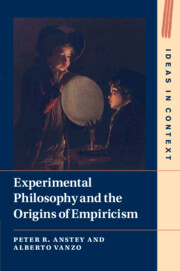Refine search
Actions for selected content:
13588 results in History of science and technology
Chapter 3 - Experimental Natural History
- from Part I - The Rise of Experimental Philosophy
-
- Book:
- Experimental Philosophy and the Origins of Empiricism
- Published online:
- 17 February 2023
- Print publication:
- 23 February 2023, pp 75-108
-
- Chapter
- Export citation
Manuscripts Cited
-
- Book:
- Experimental Philosophy and the Origins of Empiricism
- Published online:
- 17 February 2023
- Print publication:
- 23 February 2023, pp 299-299
-
- Chapter
- Export citation
Chapter 4 - Mathematical Experimental Philosophy
- from Part II - The Heyday of Experimental Philosophy
-
- Book:
- Experimental Philosophy and the Origins of Empiricism
- Published online:
- 17 February 2023
- Print publication:
- 23 February 2023, pp 111-148
-
- Chapter
- Export citation
Chapter 2 - Experimental Philosophy in the Seventeenth Century
- from Part I - The Rise of Experimental Philosophy
-
- Book:
- Experimental Philosophy and the Origins of Empiricism
- Published online:
- 17 February 2023
- Print publication:
- 23 February 2023, pp 43-74
-
- Chapter
- Export citation
Chapter 8 - Kant and the Genesis of Empiricism
- from Part III - From Experimental Philosophy to Empiricism
-
- Book:
- Experimental Philosophy and the Origins of Empiricism
- Published online:
- 17 February 2023
- Print publication:
- 23 February 2023, pp 234-257
-
- Chapter
- Export citation
Chapter 7 - Experimental Philosophy in Eighteenth-Century Germany
- from Part III - From Experimental Philosophy to Empiricism
-
- Book:
- Experimental Philosophy and the Origins of Empiricism
- Published online:
- 17 February 2023
- Print publication:
- 23 February 2023, pp 203-233
-
- Chapter
- Export citation
Copyright page
-
- Book:
- Experimental Philosophy and the Origins of Empiricism
- Published online:
- 17 February 2023
- Print publication:
- 23 February 2023, pp iv-iv
-
- Chapter
- Export citation
Tables
-
- Book:
- Experimental Philosophy and the Origins of Empiricism
- Published online:
- 17 February 2023
- Print publication:
- 23 February 2023, pp vii-vii
-
- Chapter
- Export citation
Chapter 1 - The Origins of the Experimental/Speculative Distinction
- from Part I - The Rise of Experimental Philosophy
-
- Book:
- Experimental Philosophy and the Origins of Empiricism
- Published online:
- 17 February 2023
- Print publication:
- 23 February 2023, pp 19-42
-
- Chapter
- Export citation
Newspapers, Broadsheets, and Almanacs
-
- Book:
- Experimental Philosophy and the Origins of Empiricism
- Published online:
- 17 February 2023
- Print publication:
- 23 February 2023, pp 300-300
-
- Chapter
- Export citation
A Note on Citations
-
- Book:
- Experimental Philosophy and the Origins of Empiricism
- Published online:
- 17 February 2023
- Print publication:
- 23 February 2023, pp x-x
-
- Chapter
- Export citation
Part I - The Rise of Experimental Philosophy
-
- Book:
- Experimental Philosophy and the Origins of Empiricism
- Published online:
- 17 February 2023
- Print publication:
- 23 February 2023, pp 17-108
-
- Chapter
- Export citation
Index
-
- Book:
- Experimental Philosophy and the Origins of Empiricism
- Published online:
- 17 February 2023
- Print publication:
- 23 February 2023, pp 353-366
-
- Chapter
- Export citation
Abbreviations
-
- Book:
- Experimental Philosophy and the Origins of Empiricism
- Published online:
- 17 February 2023
- Print publication:
- 23 February 2023, pp xi-xii
-
- Chapter
- Export citation

Experimental Philosophy and the Origins of Empiricism
-
- Published online:
- 17 February 2023
- Print publication:
- 23 February 2023
Satellite images as tools of visual diplomacy: NASA's ozone hole visualizations and the Montreal Protocol negotiations
-
- Journal:
- The British Journal for the History of Science / Volume 56 / Issue 2 / June 2023
- Published online by Cambridge University Press:
- 13 February 2023, pp. 247-267
- Print publication:
- June 2023
-
- Article
- Export citation
The winter of raw computers: the history of the lunar and planetary reductions of the Royal Observatory, Greenwich
-
- Journal:
- The British Journal for the History of Science / Volume 56 / Issue 1 / March 2023
- Published online by Cambridge University Press:
- 10 February 2023, pp. 65-81
- Print publication:
- March 2023
-
- Article
- Export citation
Colouring flowers: books, art, and experiment in the household of Margery and Henry Power
-
- Journal:
- The British Journal for the History of Science / Volume 56 / Issue 1 / March 2023
- Published online by Cambridge University Press:
- 13 January 2023, pp. 21-43
- Print publication:
- March 2023
-
- Article
-
- You have access
- Open access
- HTML
- Export citation
Antonio Stoppani's ‘Anthropozoic’ in the context of the Anthropocene
-
- Journal:
- The British Journal for the History of Science / Volume 56 / Issue 1 / March 2023
- Published online by Cambridge University Press:
- 13 January 2023, pp. 103-114
- Print publication:
- March 2023
-
- Article
-
- You have access
- Open access
- HTML
- Export citation
Philippe Fontaine and Jefferson D. Pooley, Society on the Edge: Social Science and Public Policy in the Postwar United States Cambridge: Cambridge University Press, 2020. Pp. 280. ISBN 978-1-1084-8713-9. £74.99 (hardback). ISBN 978-1-1087-3219-2. £26.99 (paperback).
-
- Journal:
- The British Journal for the History of Science / Volume 56 / Issue 1 / March 2023
- Published online by Cambridge University Press:
- 09 January 2023, pp. 132-134
- Print publication:
- March 2023
-
- Article
- Export citation
